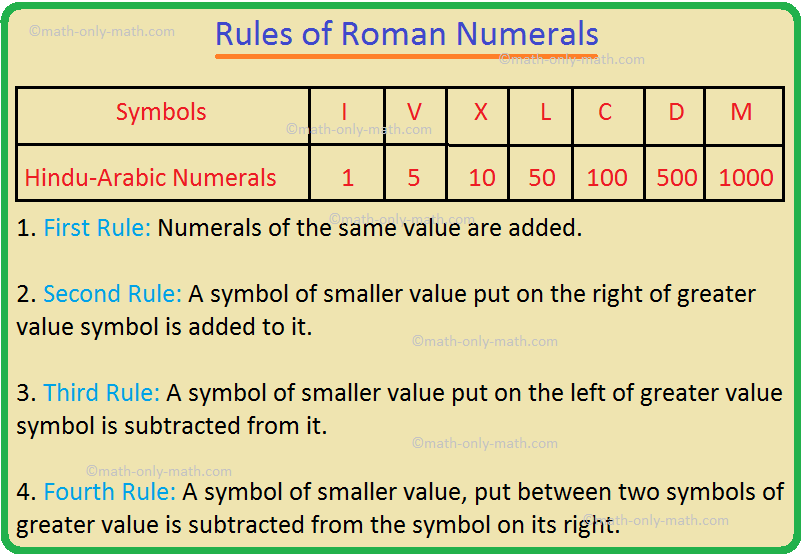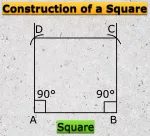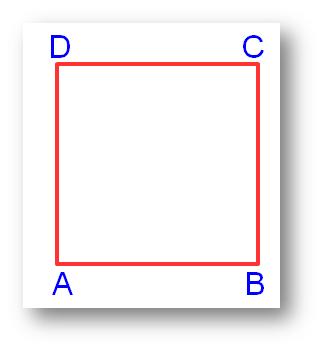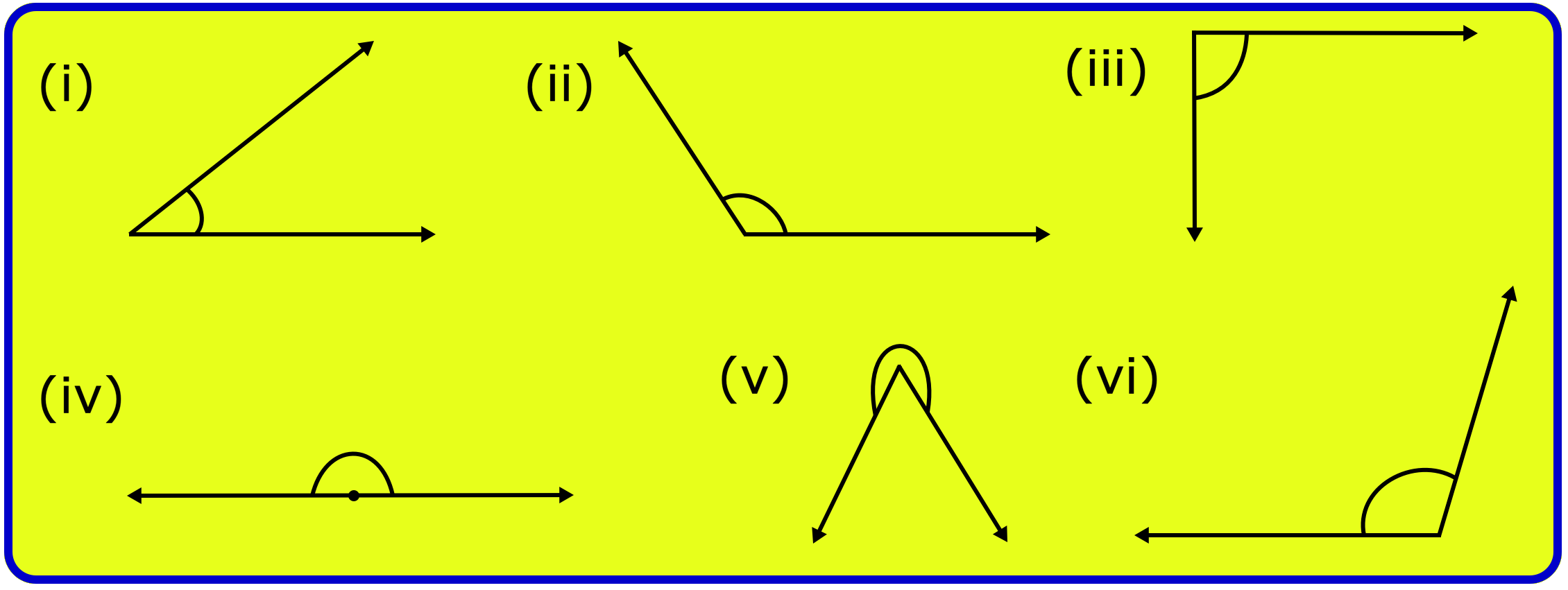Subscribe to our ▶️YouTube channel🔴 for the latest videos, updates, and tips.
Home | About Us | Contact Us | Privacy | Math Blog
Rules of Roman Numeration
We will learn about Roman Numeration and its rules. We know that there are seven basic Roman Numerals. They are I, V, X, L, C, D and M. These numerals stand for the number 1, 5, 10, 50, 100, 500 and 1000 respectively. We already learned about the numerals I, V, X, L and C and now we will learn about the remaining two numerals.
Rules of Roman Numeration:
1. First Rule: Numerals of the same value are added.
When the same symbol is repeated, the value of the symbol is added to get the value of the numeral. I, X and C can be repeated only up to three times. i.e., We can use I, X, C and M only thrice in a combination.
Symbols V, L and D are never repeated.
Symbols V, L and D cannot be used more than once in a number. We write V for 5 but we cannot write VV for 10 or VVV for 15.
Similarly, we write L for 50 but we cannot write LL = 100 or LLL 150.
D can also not be repeated in any number. We write D for 500 but we cannot write DD for 1000 or DDD for 1500.
For example:
I stands for 1
II stands for 1 + 1 = 2
II stands for 1 + 1 + 1 = 3
X stands for 10
XX stands for 10 + 10 = 20
XXX stands for 10 + 10 + 10 = 30
C stands for 100
CC stands for 100 + 100 = 200
CCC stands for 100 + 100 + 100 = 300
M stands for 1000
MM stands for 1000 + 1000 = 2000
MMM stands for 1000 + 1000 + 1000 = 3000
But we cannot write IIII for 4, XXXX for 40, CCCC for 400 or MMMM for 4000.
Note:
(i) Symbols V, L and D are not repeated.
(ii) A symbol cannot be repeated more than three times.
2. Second Rule: A symbol of smaller value put on the right of greater value symbol is added to it.
The values of the symbols are added or subtracted to find the values of the Roman numerals. When the smaller numeral is written to the right of a greater numeral, the value of the smaller numeral is added to the greater numeral.
I, X, C are the only symbols used for addition as well as subtraction. When we use them to the right of a number, they are added to the number.
For example:
VI stands for 5 + 1 = 6
XI stands for 5 + 1 = 6
LX = 50 + 10 = 60
CV = 100 + 5 = 105
CX = 100 + 10 = 110
CXX stands for 100 + 10 + 10 = 120
DC = 500 + 100 = 600
MC = 1000 + 100 = 1100
MCL stands for 1000 + 100 + 50 = 1150
Note: (i) We can add X to L and C only.
LX = 50 + 10 = 60
CX = 100 + 10 = 110
We cannot write MX for 1010
(ii) We can add C to D and M only.
For example,
DC = 500 + 100 = 600
MC = 1000 + 100 = 1100
3. Third Rule. A symbol of smaller value put on the left of greater value symbol is subtracted from it.
When the smaller numeral is written to the left of a greater numeral, the value of the smaller numeral is subtracted from the greater numeral.
I, X, C are the only symbols used for addition as well as subtraction. When we use them to the left of a number, they are subtracted from the number
The V, L and D are not subtracted. Only one number can be subtracted from another.
For example:
IV stands for 5 - 1 = 4
IX stands for 10 - 1 = 9
XL stands for 50 - 10 = 40
XC stands for 100 - 10 = 90
CD stands for 500 - 100 = 400
CM stands for 1000 - 100 = 900
Note:
(i) Symbol V, L and D are never subtracted.
(ii) Symbol I can be subtracted from V and X only.
(iii) Symbol X can be subtracted from L and C only as L and C are greater than X.
For example,
XL = 50 - 10 = 40
XC = 100 - 10 = 90
We cannot write XD for 490
(iv) Symbol C can be subtracted from D and M only.
For example,
CD = 500 - 100 = 400
CM = 1000 - 100 = 900
4. Fourth Rule. A symbol of smaller value, put between two symbols of greater value is subtracted from the symbol on its right.
When the symbols are combined to make a numeral, the value of the symbol between the two symbols is subtracted from the value of the symbol on its right.
For example:
XIV stands for 10 + 5 - 1 = 14
LIX stands for 50 + 10 - 1 = 59
XCIX stands for 90 + 10 - 1 = 99
XLIX stands for 40 + 10 - 1 = 49
Note:
(i) We never use I to the left or right of any number except V and X.
For example,
VI = 6
IV = 4
XI = 11
IX = 9
We cannot write LI = 51 or ID = 499
(ii) Bigger Roman numbers are also expressed in the same way as we express smaller Roman numbers.
For example, 2511 is expressed as MMDXI.
(MMDXI = 1000 + 1000 + 500 + 10 + 31
1. What are the 7 symbols to form different Roman numbers?
1. What are the 7 symbols to form different Roman numbers?
Answer:
We use seven symbols — LV, XL, C, D and M to form different Roman numbers. As you know that I means 1, V means 5, X means 10, L means 50, C means 100, D means 500 and M means 1000.
From Roman Numeration to HOME PAGE
Didn't find what you were looking for? Or want to know more information about Math Only Math. Use this Google Search to find what you need.
Recent Articles
-
Formation of Numbers | Smallest and Greatest Number| Number Formation
Jul 15, 25 11:46 AM
In formation of numbers we will learn the numbers having different numbers of digits. We know that: (i) Greatest number of one digit = 9, -
Formation of Square and Rectangle | Construction of Square & Rectangle
Jul 15, 25 02:46 AM
In formation of square and rectangle we will learn how to construct square and rectangle. Construction of a Square: We follow the method given below. Step I: We draw a line segment AB of the required… -
5th Grade Quadrilaterals | Square | Rectangle | Parallelogram |Rhombus
Jul 15, 25 02:01 AM
Quadrilaterals are known as four sided polygon.What is a quadrilateral? A closed figure made of our line segments is called a quadrilateral. For example: -
5th Grade Geometry Practice Test | Angle | Triangle | Circle |Free Ans
Jul 14, 25 01:53 AM
In 5th grade geometry practice test you will get different types of practice questions on lines, types of angle, triangles, properties of triangles, classification of triangles, construction of triang… -
5th Grade Circle Worksheet | Free Worksheet with Answer |Practice Math
Jul 11, 25 02:14 PM
In 5th Grade Circle Worksheet you will get different types of questions on parts of a circle, relation between radius and diameter, interior of a circle, exterior of a circle and construction of circl…








New! Comments
Have your say about what you just read! Leave me a comment in the box below. Ask a Question or Answer a Question.